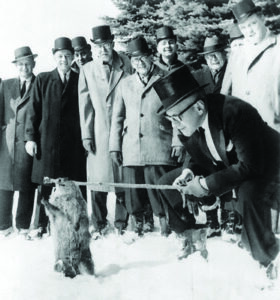By Dr. Beth Leermakers
As Groundhog Day approaches, inquiring minds want to know, “Will Punxsatawney Phil see his shadow, condemning us to six more weeks of winter?” The origins of this peculiar tradition date back to the early days of Christianity in Europe, when the skies on Candlemas Day (February 2) were the key to predicting winter’s length. Clear skies indicated an extended winter, while cloudy conditions meant spring would soon arrive.
In 1678 the naturalist John Ray wrote:
If Candlemas be fair and bright,
Winter has another flight.
If on Candlemas day it be showre [sic] and rain
Winter will not come again.
The Germans added a rodent meteorologist to this popular myth. If it was sunny on Candlemas, a badger would cast its shadow, forecasting snow into May. When German immigrants settled in Pennsylvania in the 1700s, they replaced hedgehogs with groundhogs, critters that were prevalent in the area. On February 2, 1886, Clymer Freas, editor of the Punxsutawney Spirit Newspaper, proclaimed Punxsutawney Phil to be the official weather forecasting groundhog.

According to the Punxsutawney Groundhog Club’s records, Phil has predicted “more winter” a whopping 99 times, while forecasting an “early spring” only 15 times. The accuracy of Phil’s predictions (for Pennsylvania) is a modest 39 percent, according to weather data from the Stormfax Almanac.
Hibernation Hijinks
Groundhogs, also known as Woodchucks, belong to the marmot (ground squirrel) species. Groundhogs are the largest ground squirrels, tipping the scales at 12 to 15 pounds. These “ground” squirrels are also good swimmers and can climb tall trees and shrubs. Exclusive to North America, these rodents are affectionately called whistle-pigs for their amorous serenades during mating season.
Groundhogs are one of the few animals that are true hibernators — entering a deep sleep from the late fall until March. During the warm months, groundhogs bulk up by bingeing on vegetation — up to a pound per meal. That’s the equivalent of a 150-pound person devouring a 15-pound steak.
Fast growing teeth accommodate a voracious appetite. To handle all that roughage, groundhogs’ teeth grow about 1/16th of an inch per week. When they are properly aligned, woodchuck upper and lower incisors grind each other down with every bite, keeping the teeth short. If the chompers are misaligned, they keep growing until they resemble tusks that can impale the rodent’s lower jaw, killing the poor animal.
During their 3-month hibernation, woodchucks’ bodily functions slow dramatically, reducing energy needs:
• Body temperature drops from 99 degrees to as low as 37 degrees Fahrenheit. For comparison, people lose consciousness when their body temperature drops to 82 degrees and die below 70 degrees Fahrenheit.
• Heart rate decreases from 80 beats per minute to five.
• Breathing slows from 16 breaths per minute to two.
• Groundhogs only lose about 1/4 of their body weight, due to their decreased metabolism.
Chivalry isn’t dead. In February, male groundhogs leave their underground burrows, looking for females. Males enter a female’s burrow and may spend the night — not to mate, but to get acquainted. Mating occurs when woodchucks emerge from hibernation for good in March. Females give birth to two to six babies (called pups, kits and cubs) after a gestation period of around 32 days. The babies are born blind and hairless but mature quickly, leaving their mother to dig their own burrows when they are three months old. Groundhogs in the wild typically live three to six years.
How Much Wood Would a Woodchuck Chuck if a Woodchuck Could
Chuck Wood?
According to Cornell University, a wildlife biologist answered the question posed in the popular tongue twister. The biologist measured the volume of a woodchuck burrow, which can be more than 20 feet long, and estimated that it would take 700 pounds of wood to fill the hole. Woodchucks aren’t known for their wood-chucking prowess, and they rarely eat wood. In fact, the name woodchuck has nothing to do with wood. “Woodchuck” comes from a Native American word, wuchak, which translates as “digger.”
Whatever happens on February 2, let’s hope winter ends soon. Happy Groundhog Day, everyone!
